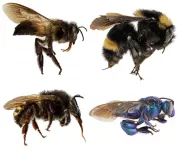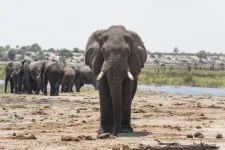(Press-News.org) COLUMBUS, Ohio - Thermoelectric power generators that make electrical power from waste heat would be a useful tool to reduce greenhouse gas emissions if it weren't for a most vexing problem: the need to make electrical contacts to their hot side, which is often just too hot for materials that can generate a current.
The heat causes devices to fail over time.
Devices known as transverse thermoelectrics avoid this problem by producing a current that runs perpendicular to the conducting device, requiring contacts only on the cold end of the generator. Though considered a promising technology, the materials known to create this sideways voltage are impractically inefficient - or so scientists thought.
Ohio State University researchers show in a new study that a single material, a layered crystal consisting of the elements rhenium and silicon, turns out to be the gold standard of transverse thermoelectric devices.
The scientists demonstrated that this single compound functions as a highly effective thermoelectric generator because of a rare property: simultaneously carrying both positive and negative charges that can move independently rather than running parallel to each other, which forces them to zig-zag their way to the contacts to generate an electrical current.
By building a thermoelectric generator with a crystal about two inches long, the researchers also determined that when the crystal is situated at a specific angle in the device, it can churn out an impressive amount of power.
"We showed that these materials are as effective as conventional thermoelectric generator technology, but overcome its major disadvantages," said study co-author Joshua Goldberger, professor of chemistry and biochemistry at Ohio State.
"This is the first time this kind of device has ever been shown to be feasible. With efficiencies that are orders of magnitude higher than any previous transverse device, this compound is just as good as what you can buy commercially, but promises to be much simpler and more reliable."
The research is published online in the journal Energy & Environmental Science.
While 97% of energy is generated from heat, we throw most heat away, letting it escape from smokestacks, car exhaust pipes and the like.
"Waste heat is really important. Forever and ever there has been a quest to improve the efficiency of all engines that make power from heat - the amount of work you can get out of them that you can use," said study co-author Joseph Heremans, professor of mechanical and aerospace engineering and Ohio Eminent Scholar in Nanotechnology at Ohio State.
"For a long time, we've dreamt of finding little engines that would not have moving parts that can take heat and make electricity."
And now they have.
Most materials conduct only one type of charge, causing most thermoelectric devices to be composed of multiple compounds - yet the complexity of making contacts to them has hampered efforts to build an efficient and effective thermoelectric generator that is easy to construct and can withstand high temperatures.
Two years ago, this research team discovered unexpected properties in a different compound that allowed electrons and holes, the sources of the negative and positive charges, respectively, that generate an electrical current, to run along what might resemble a north-south highway for one charge and an east-west highway for the other.
After that discovery, the researchers combed through existing research on other crystals that had been found by other scientists to do the same thing.
"We got interested in this because at first, we didn't realize it could exist. When we figured out it could exist, we've been really pushing to find these materials," Goldberger said. To date, they've experimentally confirmed 15 materials with these properties - out of the over 110,000 crystal structures discovered and cataloged in an international database.
"A few had been discovered, but none was exploited for functionality. What we have found is that we can actually do something with it," said Wolfgang Windl, a professor of materials science and engineering at Ohio State and co-author of the study.
"All we have to do is put wires to one end and orient the crystal a certain way and suddenly we have a power generator with no moving parts. And you make it warm with whatever waste heat you have in your home, car or rocket, and this will generate emission-free power all by itself and basically endlessly. It's a little bit like black magic to me."
Theoretically, a generator made with this compound could be put to use any place heat is generated - the size of the crystal can be variable, and in this study was dictated by the size of the furnace in which it was grown.
Heremans said the generator could produce enough electricity from car exhaust to propel the vehicle forward, but he favors the idea of using this technology on a smaller scale: "The smaller-scale applications are where complex solutions are not welcome because they're too expensive," he said. "That's where a simple solution like this one is probably best."
INFORMATION:
This work was supported by the Air Force Office of Scientific Research, the U.S. Department of Energy and the National Science Foundation Emerging Frontiers in Research and Innovation. The crystal growth was supported by the National Science Foundation Platform for the Accelerated Realization, Analysis and Discovery of Interface Materials (PARADIM).
Co-authors include Michael Scudder, Bin He (now at the Max Planck Institute) and Yaxian Wang (now at Harvard University) of Ohio State and Akash Rai and David Cahill of the University of Illinois at Urbana-Champaign.
Contacts:
Joshua Goldberger, goldberger.4@osu.edu
Joseph Heremans, heremans.1@osu.edu
Wolfgang Windl, windl.1@osu.edu
Written by Emily Caldwell, caldwell.151@osu.edu
DURHAM, N.H.--Researchers at the University of New Hampshire have conducted two of the first studies in New England to collectively show that toxic man-made chemicals called PFAS (per-and polyfluoroalkyl substances), found in everything from rugs to product packaging, end up in the environment differently after being processed through wastewater treatment facilities--making it more challenging to set acceptable screening levels.
"PFAS are persistent substances that are not easily broken down and have been linked to adverse health effects," said Paula Mouser, associate professor of civil and environmental engineering. "They are found in a wide variety of industrial, commercial and medicinal products and can end up in the body, human waste and the environment. If not managed correctly, they ...
In a new study, scientists at The Hong Kong University of Science and Technology (HKUST) have revealed that most T cell epitopes known to be targeted upon natural infection are seemingly unaffected by current SARS-CoV-2 variants.
In their latest research, the team compiled and analysed data from 18 immunological studies of T cell responses involving over 850 recovered COVID-19 patients from across four continents who are well-distributed in age, gender, disease severity and blood collection time. They demonstrated that T cells in these patients targeted fragments (epitopes) of almost all of ...
Rough night of sleep? Relying on caffeine to get you through the day isn't always the answer, says a new study from Michigan State University.
Researchers from MSU's Sleep and Learning Lab, led by psychology associate professor Kimberly Fenn, assessed how effective caffeine was in counteracting the negative effects of sleep deprivation on cognition. As it turns out, caffeine can only get you so far.
The study -- published in the most recent edition of Journal of Experimental Psychology: Learning, Memory, & Cognition -- assessed the impact of caffeine after a night of sleep deprivation. More than 275 participants were asked to complete a ...
Reverse transcription-polymerase chain reaction (RT-PCR) has been the gold standard for diagnosis during the COVID-19 pandemic. However, the PCR portion of the test requires bulky, expensive machines and takes about an hour to complete, making it difficult to quickly diagnose someone at a testing site. Now, researchers reporting in ACS Nano have developed a plasmofluidic chip that can perform PCR in only about 8 minutes, which could speed diagnosis during current and future pandemics.
Rapid diagnosis of COVID-19 and other highly contagious viral diseases is important for timely medical care, quarantining ...
Adults with schizophrenia have an elevated risk of dying from suicide. Yet there's only limited understanding of when and why people with schizophrenia die of suicide --in part because research studies have looked at relatively small groups of patients.
Now a new study from Columbia that looked at a large population of adults diagnosed with schizophrenia has found the youngest group (18-34) had the highest suicide risk and those aged 65 and older had the lowest. By comparison, in the general U.S. population, younger adults have less risk and older age groups have greater risk.
The Columbia study, published online May 26 in the journal JAMA Psychiatry, (LINK TK) also showed that people with schizophrenia, overall, have a 4.5-fold increased risk of dying from suicide, ...
When enjoying a chocolate bar, most people don't think about how the molecules within it are organized. But different arrangements of the fats in chocolate can influence its taste and texture. Now, researchers reporting in ACS' Crystal Growth & Design have found that the side of a chocolate bar facing the mold has a more orderly crystalline structure than the side facing air, knowledge that might help chocolatiers produce tastier confections, the researchers say.
Chocolate is a mixture of cocoa solids, cocoa butter, sugar and other ingredients that interact with each other in complex ways. In particular, the fat molecules, or triacylglycerols, can remain liquid or crystallize into several phases with different melting points. ...
Several indicators point to the adverse impacts of climate change on the planet’s vegetation, but a little-known positive fact is the existence of climate-change refugia in which trees are far less affected by the gradual rise in temperatures and changing rainfall regimes. Climate-change refugia are areas that are relatively buffered from climate change, such as wetlands, land bordering water courses, rocky outcrops, and valleys with cold-air pools or inversions, for example.
A study conducted in Peruaçu Caves National Park in the state of Minas Gerais, Brazil, with FAPESP’s support, confirmed and quantified ...
A mathematical model which can predict landslides that occur unexpectantly has been developed by two University of Melbourne scientists, with colleagues from GroundProbe-Orica and the University of Florence.
Professors Antoinette Tordesillas and Robin Batterham led the work over five years to develop and test the model SSSAFE (Spatiotemporal Slope Stability Analytics for Failure Estimation), which analyses slope stability over time to predict where and when a landslide or avalanche is likely to occur.
In a study published in Scientific Reports, ...
Annapolis, MD; May 26, 2021--A new study has mounted perhaps the most intricate, detailed look ever at the diversity in structure and form of bees, offering new insights in a long-standing debate over how complex social behaviors arose in certain branches of bees' evolutionary tree.
Published today in Insect Systematics and Diversity, the report is built on an analysis of nearly 300 morphological traits in bees, how those traits vary across numerous species, and what the variations suggest about the evolutionary relations between bee species. The result offers strong evidence that complex social behavior developed just once in pollen-carrying bees, rather than twice or more, separately, in different evolutionary branches--but ...
Travelling elephants pay close attention to scent trails of dung and urine left by other elephants, new research shows.
Scientists monitored well-used pathways and found that wild African savannah elephants - especially those travelling alone - were "highly attentive", sniffing and tracking the trail with their trunks.
This suggests these scents act as a "public information resource", according to researchers from the University of Exeter and Elephants for Africa.
More research is now needed to find out whether humans can create artificial elephant trails to divert elephants away from farms and villages, where conflict with humans can cause devastation to communities.
Alternatively, scent trails could be placed to improve the efficiency of routes ...





